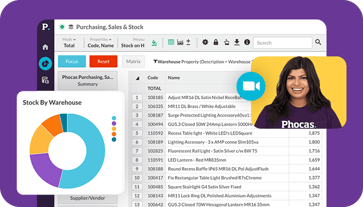Retail success means data sharing
The retail industry is a tough and competitive environment. With every business trying to top one another, it becomes all the more difficult to bring in new customers. The key to retail success in such a cut-throat environment is via your data. The more you know about your customers, the better positioned you'll be to deliver a more personalized shopping experience without blowing out cost-to-serve.
To successfully beat the competition in today’s market, suppliers, wholesalers and retailers must collaborate to optimize every process across the entire supply chain – from the factory floors to the storage warehouses and the distribution networks, then to the retail outlet or website and finally, to the customer.
How can this be achieved?
Data Sharing
Retailers and suppliers should collaborate in sharing and analyzing a common set of data. By measuring and reporting on a common set of data, both parties will be on the same page, analyzing the same data and getting the same results.
There are two key types of data that retailers and suppliers should share:
1. Sell-Thru Data
Sell Thru data is the key information a retailer uses when determining the next order to make from the supplier. Sell-thru data includes:
- Scanned sales or Register Sales
- Qty stock on order
- Qty stock on hand
- Orders categorised by SKU
- Orders categorised by store
Giving suppliers access to this information delivers a number of benefits to both the retailer and suppliers. If everyone has a clearer picture of what’s happening in the store or online then the likelihood of running out of stock or over stocking is greatly reduced. Improved accuracy in demand forecasting will allow retailers to better plan their purchasing schedule and allow suppliers to improve manufacturing and distribution processes.
Essentially, both retailers and suppliers can greatly reduce costs and improve efficiency. Ultimately, these efficiencies will translate into cost reductions in the delivery of the final goods to the customer.
2. Product categories
Retailers and suppliers should place a greater focus on managing groups of products instead of individual product ranges. Suppliers and retailers should group similar products based on the way it addresses their consumers’ needs. Then, each category is viewed as its own line of business.
By measuring sales by category and sharing the results, both retailers and suppliers will get an overarching view of the products that aligns with their customers’ needs. Analysis of this data can help identify slow-moving and fast-moving product categories, thereby giving both parties an opportunity to cut their losses by focusing on high-demand categories.
Additionally, suppliers and retailers work together to promote the turnover of the entire category not an individual product. If a supplier wants to introduce a new product it has to be beneficial to the entire category before the retailer places an order for it.
To successfully manage products categorically, retailers and suppliers must have a greater degree of collaboration. Instead of the traditional adversarial relationship, the supplier and retailer must work together to build their businesses as partners.
The Overall Benefit: A Holistic View of the Supply Chain
Improved transparency of key business drivers obtained from sharing data can help establish a single holistic view of the supply chain. The retailer and supplier can respond quicker and more effectively to trends and opportunities in the market. Improved trust results in more effective communication and productive relationships that increase revenue for both the supplier and retailer.
Ultimately, through data sharing, retailers and suppliers have the opportunity to enhance the complete buying and selling process, which will not only bring in tangible benefits to both, but also translate into benefits for the end customer.


Empowering businesses with intuitive data analytics, driving informed decisions for growth and profitability. We make people feel good about data.
Related blog posts

DIFOT (Delivered In-Full, On-Time) or OTIF (On-Time In-Full) is a fundamental KPI when analyzing the performance of your supply chain. The main goal is to get your customers the products they need, when they need them, in the quantity they ordered. DIFOT measures how successful your business is at achieving this objective and identifies procurement problems and supplier reliability.
Read more
Picture a football coach preparing for the big game. He watches game‑tape, studying player metrics, analyzing every play and using real‑time stats to inform strategy. That’s exactly how sales managers and sales leaders should approach their coaching program—with a data‑driven approach.
Read more
Sales professionals operate in face-paced environments with savvy customers who have a lot of choice. Whether you're in B2B sales or working with consumers, the sales process is challenging with longer sales cycles, more decision-makers and higher expectations for follow-up and advice. To stay competitive, sales reps and sales teams need the best sales tools to reduce administrative tasks and improve sales team performance.
Read more
“Free BI tools trial, business analytics software for free, free BI reporting with AI-powered insights”– these offers are tempting business people all the time especially as new open-source players enter the market and want cut-through.
Read moreBrowse by category

Find out how our platform gives you the visibility you need to get more done.
Get your demo today